Kanban: Definition, 6 Rules, and its Benefits
Kanban is a crucial part of the Just in Time (JIT) system, which we discussed…
Sean Thobias
May 17, 2025In today’s digital world, having a solid online presence is vital for businesses and websites to succeed. That’s where Search Engine Optimization (SEO) comes in. It is like the secret code search engines use to find and rank websites based on relevance and credibility.
By understanding and applying its basics, you can make your website more visible on search engine results pages, attract more organic traffic, and drive growth for your online presence.
The strategy can be overwhelming if you’re new to the concept. However, this is where our guide comes in. We’ll break down the complex concepts to guide you through each step of the SEO journey.
We’ll explore its fundamentals, search engines, keyword research, on-page optimization, technical aspects, and more. By the end of this guide, you’ll have a solid understanding of the core principles of SEO, empowering you to make informed decisions and take actionable steps to improve your website’s search engine rankings.
The SEO we know today is about improving websites and online content to make them more visible and higher-ranked on search engine results pages (SERPs).
The strategy’s primary goal is to attract more visitors from search engines by making websites more relevant and appealing to search engines and users. Search engines like Google, Bing, and Yahoo! are essential for SEO. They go through websites, organize them, and decide their ranking based on relevance and quality.
When a website is optimized, it has a higher chance of showing up at the top of search results. It makes it easier for people to click on it, visit the site, and become customers.
Search Engine Optimization is crucial for making your website easier to find on search engines and providing other valuable benefits. Let’s look at some of these benefits:
Read more: Unlocking Growth: 19 Traction Channels for Business Success
Many people mix up SEO and SEM (Search Engine Marketing), but they are different. Search Engine Optimization is about improving your website to make it easier for people to find when they search online. It aims to attract organic traffic.
On the other hand, SEM is a paid digital marketing strategy that boosts the visibility of your business’s products or services on search engine result pages (SERPs).
Here’s a table summarizing the key distinctions between SEM and SEO.
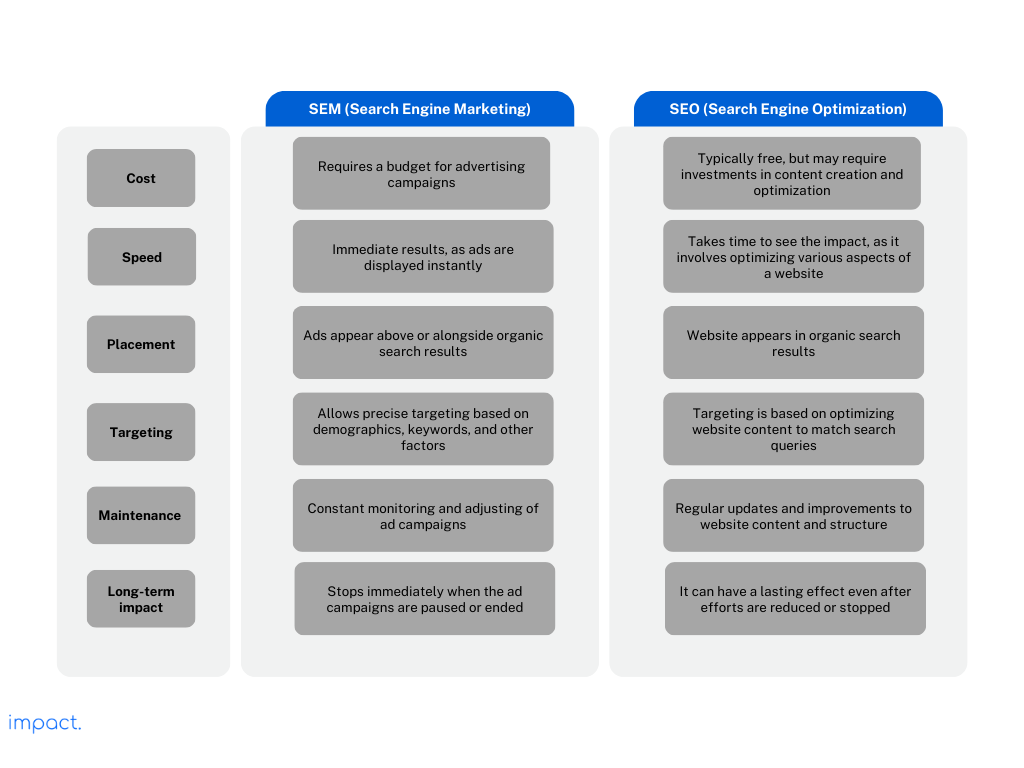
Read more: SEM: Definition and 3 Mechanics to Appear Higher on Searches
Here are three common types of Search Engine Optimization used to improve website visibility and rankings. We will discuss these different types in further detail in the upcoming chapters of our guide.
This type focuses on optimizing your website’s content and structure to make it more appealing to search engines.
On-site SEO involves techniques such as:
On-page SEO is essential for ensuring that search engines understand what your website is about and rank it higher in search results.
This type deals with the technical aspects of your website that affect its search engine visibility and crawling. Technical SEO ensures that search engines can easily access, crawl, and index your website’s pages.
Technical SEO involves:
Technical SEO helps improve the overall user experience. It makes it easier for search engines to understand and rank your website.
Unlike on-page SEO, this type is all about activities outside your website that still impact its search engine rankings. The main focus here is building high-quality backlinks from other websites to your own.
Backlinks act as “votes of confidence” for search engines, indicating that your website is trustworthy and authoritative. Off-page SEO involves social media marketing, influencer outreach, and online reputation management. These efforts help increase your website’s visibility, credibility, and overall online presence.
Read more: Social Media Marketing: A Guide & 3 Strategies for Success
If you want your website to appear higher in search engine results and get more visitors, here are some essential SEO tips. These best practices will help you improve your site’s visibility and attract more traffic.
Don’t use sneaky tactics like Black Hat to trick search engines and improve your ranking. Things like stuffing your content with too many keywords, hiding text, and using shady link schemes can get you in trouble with search engines. Avoiding these practices is essential because they can lead to penalties and harm your website’s visibility.
Optimizing your website for mobile users is crucial to attract more visitors and improving your website’s performance. Ensure your site loads quickly, works well on different screen sizes, and provides a seamless experience.
People expect websites to load in about 3 seconds or less. If it takes longer, around 40% of users might leave. Plus, mobile optimization keeps users happy and helps your search engine rankings. The most popular search engine, Google, considers user experience a significant factor in determining search results.
Search engines like Google always make changes to improve their search results. In 2010, they made around one change daily, but in 2018, they made multiple changes daily. It’s essential to stay updated on these changes and adjust your Search Engine Optimization strategies accordingly. Stay informed by reading trustworthy blogs related to the subject and keeping up with the latest trends and algorithm updates.
Boost your Search Engine Optimization efforts with the power of social media. Engage with your audience, share your content, and encourage others to do the same. Social media signals like likes, shares, and comments can indirectly impact your search engine rankings. Plus, social media profiles and posts can appear in search results, giving you more visibility online.
Read more: Tracking SEO Performance: 11 Key Metrics to Know
Mastering the fundamentals of Search Engine Optimization is crucial for businesses aiming to increase online visibility and attract more visitors from search engines. By optimizing your website and content, you can enhance user experience, establish trust and credibility, gain a competitive advantage, measure success through measurable metrics, and improve user engagement rates. These benefits drive traffic and contribute to long-term customer advocacy and revenue growth.
In the upcoming chapter, we will delve into the mechanics of search engines and how they function. We can develop effective optimization strategies by learning how these search engines rank and organize websites. This will prove to be a valuable insight into your SEO efforts.
Impact Insight Team
Impact Insights Team is a group of professionals comprising individuals with expertise and experience in various aspects of business. Together, we are committed to providing in-depth insights and valuable understanding on a variety of business-related topics & industry trends to help companies achieve their goals.
See how our software provides better value.
Speak with our consultant to explore how we can improve your accounting, processes, and people.

When discussing using social media to promote your business, we mentioned that the content you share is crucial. It’s what keeps people interested and ensures they have a good experience. Now, let’s take a closer look at content marketing.
Content marketing is all about creating and sharing valuable and relevant content consistently. It’s not just about trying to sell something; it’s about providing value, educating, entertaining, and engaging your target audience.
By delivering helpful and meaningful content, businesses can build trust, establish relationships, and encourage customers to return.
In this chapter, we will explore the world of content marketing, its importance, and the strategies that lead to success. We’ll help you understand the benefits of content marketing, develop a content strategy, and provide practical tips on creating better content.
Content marketing is a smart way to market your business. It involves creating and sharing valuable and relevant content consistently. The goal is to attract and keep the attention of a specific group of people. Doing this can encourage them to take actions that benefit your business, like purchasing or signing up for your services.
Content marketing isn’t just publishing content and hoping people will find it. It’s about purposefully tailoring your content to your target audience. Hence, they see you in the inbound rather than the outbound way.
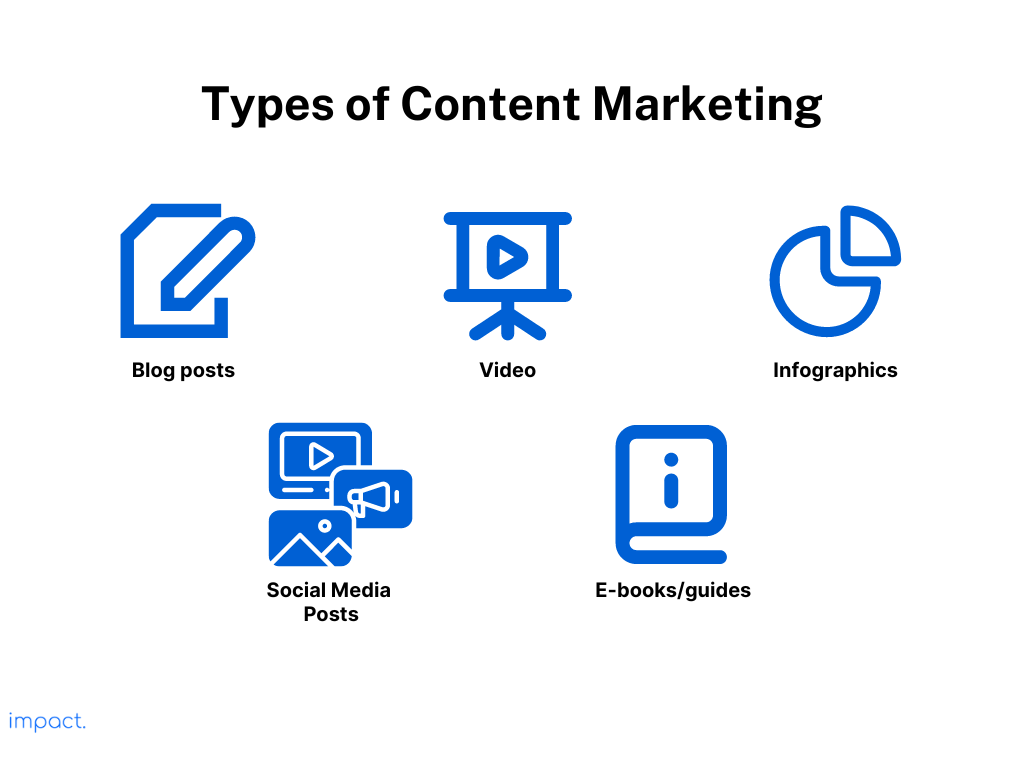
Here are some examples of content marketing:
Read more: Social Media Marketing: A Guide & 3 Strategies for Success
Content marketing is crucial in today’s digital age. Almost all brands, around 97%, use this marketing method because consumers nowadays prefer to engage with and learn about businesses online. Apart from building relationships with customers, there are several other benefits of content marketing:
Unlike regular ads, content marketing leaves a strong impression on the audience. It’s about sharing valuable and informative content that stays relevant for a long time.
With content marketing, you can create evergreen content, search-optimized content that revolves around topics that are always relevant to readers, regardless of the current news cycle or season.
You can use one piece of content repeatedly, year after year. It’s like having a valuable asset that never loses its worth and doesn’t require constant replacement. It’s cost-effective and delivers long-lasting value.
When a brand’s website expands and offers a wide range of valuable content, its reputation grows alongside it. Websites with numerous pages filled with useful information appear more trustworthy, established, and reliable.
People are more inclined to discover and interact with websites that provide comprehensive and plentiful resources. Research shows that 65% of consumers develop a positive and trusting perception of a brand after reading educational content created by that brand.
A study by Edelman found that nearly half (47%) of high-level executives willingly share their contact information after finding valuable content. Therefore, businesses must create relevant and helpful content to convert leads into paying customers.
When companies offer information that potential customers are actively seeking, it grabs their attention. By using effective content, businesses can nurture these leads and guide them through the buying process, significantly increasing the likelihood of turning them into paying customers.
Content marketing is a great way for businesses to make their brand more well-known. Creating useful and relevant content helps bring more people to your website through search engines.
If you consistently make high-quality content that answers common search questions, Google will notice and rank your website higher in search results. Sharing your content on different platforms regularly can reach more people and get their attention.
Businesses use content marketing to engage with their audience on a deeper level. Companies can cultivate a loyal following by consistently providing valuable and enjoyable content.
According to a study by Edelman, 75 percent of people who trust a brand are likely to remain loyal to it, even when faced with other alternatives. Additionally, 78 percent of these individuals are willing to share the brand’s content with others.
When customers feel strongly connected to a brand and consistently receive valuable content, they are more inclined to remain loyal and actively advocate for the business. As a result, enduring customer connections are fostered.
To create impactful content, starting with a well-planned strategy is crucial. Research has revealed that 80% of marketers achieve content marketing success with a solid plan.

A content marketing strategy is a clear roadmap for your goals. It helps you define measurable metrics for success and lays out procedures for continuous improvement. Incorporate these five essential components into your content strategy for maximum effectiveness:
A buyer persona formally represents your ideal customer or target audience. It’s like a snapshot of a typical person interested in your brand. It includes details about their age, gender, location, hobbies, preferences, and goals or pain points.
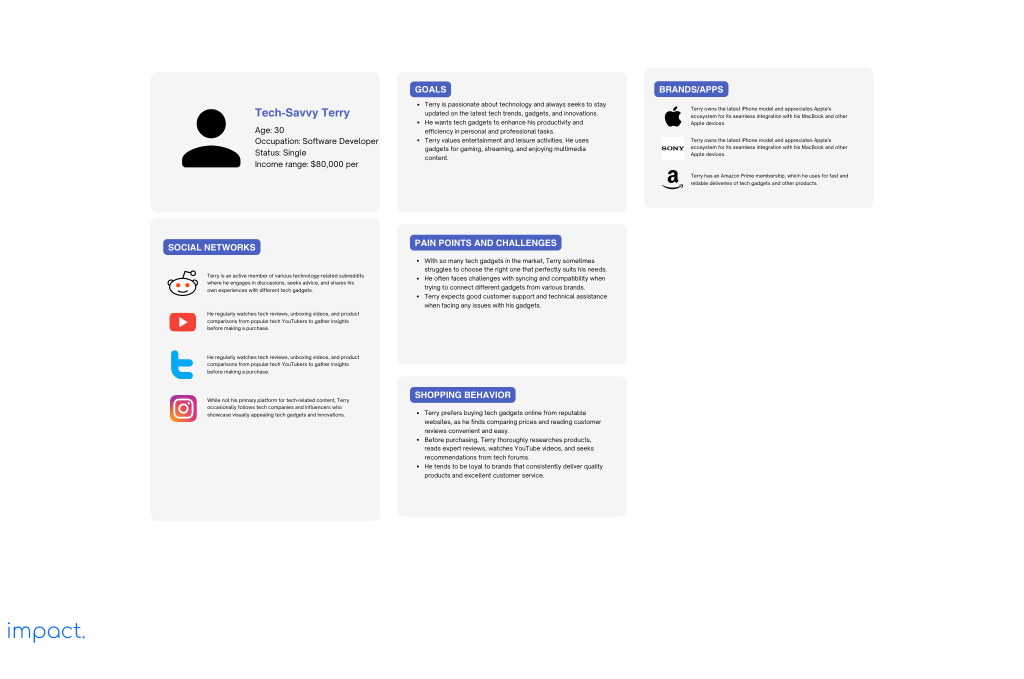
A buyer persona helps you paint a picture of the people you want to reach with your content. It provides valuable insights that guide you in crafting content that speaks directly to your customer’s interests and needs. By creating these personas, you can easily explain who your audience is to your stakeholders and anyone involved in your brand messaging.
Your brand story summarizes your company’s history, mission, purpose, and values. It’s essential to define and share this unique story with your audience. This way, you create a strong brand identity that connects with them on a deeper level.
Always remembering your brand’s story while making content ensures a consistent experience for your audience. This consistency will help build the right image across all your content marketing channels, strengthening your brand’s presence and impact.
When defining your content marketing efforts, it’s important to have a clear purpose. Identify the specific goals you want to achieve, such as increasing brand awareness, generating leads, driving conversions, or establishing thought leadership.
To create an effective content marketing mission statement, make sure to include these elements:
It’s important to understand that attracting new readers and followers is not enough for a successful content marketing plan. Your content should also contribute to the growth of your business.
To begin, identify the specific business goals that your company needs to achieve. Then, determine how content marketing can help you reach those goals.
One effective way to do this is by creating a business case. This document shows the value and importance of pursuing a project. The business case outlines the project’s goals, costs, and expected benefits. It proves that the project is a worthwhile investment, instilling confidence in stakeholders and helping garner their support.
By focusing on creating valuable content and aligning it with your business goals, you can ensure that your content marketing efforts contribute to the overall success of your company.
Finally, including an action plan in your content marketing strategy is essential. This plan should be comprehensive and provide clear guidance on effectively implementing your content strategy. Here’s how you can create an action plan that covers all the necessary aspects:
Read more: SEM: Definition and 3 Mechanics to Appear Higher on Searches
Now that you understand the key elements of a good content strategy, it’s time to create one for your content marketing goals. We have listed seven steps below to guide you through creating your content.
Start by determining what you want to achieve with your content strategy. Are you aiming to increase brand awareness, generate leads, drive website traffic, or educate your audience? Clearly defining your goals will help guide your content creation efforts.
What you can do next is to rank each goal from the most important to the least important. By prioritizing, you can identify which plans require immediate attention and which can be dealt with later. It will also assist you in figuring out the resources needed for each goal as you move forward with your strategy.
The previous section emphasizes the importance of having an audience persona in your content strategy. You must know your target’s age, interests, problems, and what they like. This knowledge helps you create content that connects with them better.
After you collect this information, you should look at the data to see if there are any common groups among your audience. These groups may have similar traits or interests.
It’s essential to revisit and study your audience regularly. This way, you can see if anything has changed and make sure you keep growing your audience. Also, looking closely at your current customers can help you improve your understanding of your target audience.
Before you start creating new content, assessing your existing content through a content audit is important. It means checking how well your current content is doing. You can look at how many people interact with it, how many visitors it brings to your website, and how many people act after seeing it.
Conducting a content audit helps you understand the performance of your current content and reveals any gaps that require new ideas to fill them. You might discover that you can repurpose some of your old content, which means using it again fresh. Repurposed content allows you to make the most out of your content on different platforms and reach a larger audience.
When creating a content strategy, choosing the right types of content that match your goals and connect with your intended audience is important. Different options exist, including blog posts, videos, infographics, podcasts, and social media content. Consider the format that best delivers your content and effectively captures your audience’s interest.
Here is the part where you consider the brand story of your overall campaign. You must decide on the main messages you want to share with your audience through your content. These messages should match your brand’s values and be something your target audience can relate to. Creating a consistent and compelling messaging strategy makes your content feel connected and well-put together.
For example, if you’re using different platforms like social media, blogs, or videos, ensure your messages remain consistent across all of them. Consistency will help your audience recognize your brand easily and understand what you stand for. Keep your language simple and easy to understand so everyone can understand your message.
Once you have set your goals, researched your target audience, audited your existing content, and defined your key messages, it’s time to start creating your content.
Developing a content calendar will help you stay organized and plan when to create and publish your content. Ensure to produce high-quality content relevant to your audience consistently and adds value. It’s important to ensure that your content aligns with your overall strategy.
Creating content doesn’t end once you publish it. After publishing, checking how well your content matches your goals regularly is important. This process involves using the metrics you established in your content strategy to assess whether your content is helping you achieve your objectives.
Keep an eye on metrics like engagement, reach, conversions, and feedback from your audience. Analyze this data to understand what’s working and what needs improvement. Take this feedback into account to make your content strategy even better.
Even with a well-defined content strategy, your content may not connect with your customers as effectively as you’d hoped. To produce higher-quality content, consider the following five tips:
Again, we emphasize understanding your customers well. Take the time to know who they are, what they like, and what they are interested in. By doing so, you can tailor your content specifically to their preferences, needs, and challenges.
A personalized approach ensures your content speaks directly to your audience and addresses their unique concerns. When your content resonates with your audience and provides valuable information, insights, or solutions, they are more likely to engage with it and find it helpful.
Storytelling is a powerful strategy in content marketing that many marketers find effective. A whopping 62% of B2B marketers consider storytelling to be a valuable tactic in their content marketing efforts.
So, what exactly is storytelling in content marketing? It involves using narrative journalism and traditional storytelling techniques to captivate and persuade your audience. The goal is to create a connection by sharing compelling stories that evoke emotions. These stories follow a familiar structure, with characters, conflict, and a sense of progression.
By incorporating storytelling into their marketing approach, brands can forge strong and meaningful relationships with potential customers and existing clients. This method allows brands to go beyond simple promotion and engage with their audience on a deeper level. When done right, storytelling can leave a lasting impact and inspire trust and loyalty in your brand.
It’s fine to reuse content, but remember this: we come across more than 5,000 brand messages daily, yet we only notice about 86, and only 12 leave a lasting impression.
So, instead of copying what others have said, try to offer something new and exciting. Come up with fresh ideas, angles, and approaches that are unexplored. Give your audience unique insights and solutions that are valuable.
This way, you can stand out from others in your field and catch your readers’ attention. Remember, the key is adding value and making your content different from the rest.
When creating content, writing in a friendly and approachable way is important. Imagine you’re having a casual conversation with your audience.
Your writing should be simple, clear, and easy to understand. Avoid using complicated jargon or technical terms that might make your readers feel left out or confused.
Instead, aim to connect with your audience using relatable language they can easily grasp. Adopting a conversational tone can build a stronger connection with your readers and make your content more enjoyable and accessible to a wider audience.
Research shows that about 65% of people learn better through visual content. If you want to grab your audience’s attention and keep them interested, add different media types to your content. Pictures, videos, infographics, and interactive elements can boost your content’s appeal.
For instance, using images can help show your ideas visually, making it easier for people to understand what you’re talking about. Videos can bring your content to life, allowing you to demonstrate things, share stories, or explain complex topics more effectively.
Including these visual elements make your content look better and more enjoyable and memorable for your readers. It’s a great way to cater to different learning styles and preferences, making your content more accessible to a broader audience.
In today’s digital world, content marketing is crucial. It involves regularly creating and sharing valuable content to educate, entertain, and engage your target audience. Doing so can build trust and establish strong relationships with your customers.
Having a well-planned content marketing strategy is crucial for creating effective content. A content marketing strategy serves as a roadmap for your goals. It enables you to measure your success and improve over time.
In the next chapter of this guide, we’ll explore the topic of search engine optimization (SEO) and how it complements digital marketing as a whole. In the meantime, be sure to implement the strategies and best practices we’ve discussed in this article to ensure the success of your content marketing.
Impact Insight Team
Impact Insights Team is a group of professionals comprising individuals with expertise and experience in various aspects of business. Together, we are committed to providing in-depth insights and valuable understanding on a variety of business-related topics & industry trends to help companies achieve their goals.
See how our software provides better value.
Speak with our consultant to explore how we can improve your accounting, processes, and people.

Poka-yoke is a vital part of Jidoka in the House of Lean Production. Its main goal is to prevent errors and defects. The manufacturing industry utilizes Poka-yoke as a standardized work technique.
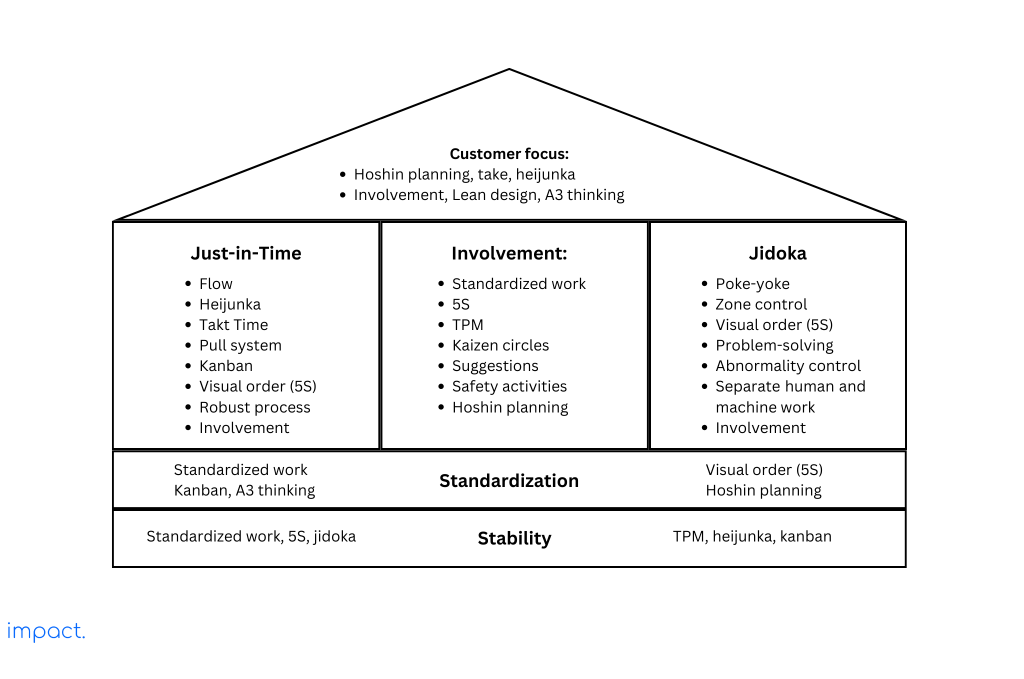
The main idea behind Poka-yoke is to stop errors and defects before they happen. Using Poka-yoke has proven to be highly effective in improving production efficiency in manufacturing. Now, let’s explore the definitions, benefits, and examples of Poka-yoke:
Poka-yoke is a concept from Japan. Shigeo Shingo coined the term, and it’s all about stopping mistakes and ensuring products are perfect without any problems.
The concept helps find potential defects early on by preventing different errors during production. Here are some common mistakes that often happen in manufacturing:
Poka-yoke uses machines or methods to help spot mistakes quickly. Its main goal is to ensure the production process doesn’t progress unless everything is correct.
Read more: Lean Manufacturing: Definition & 3 Benefits
When it detects an error, poka-yoke takes two types of actions: turning off the engine or giving a warning. Here’s the explanation:
Shutting down the engine is the most potent action of Poka yoke. Here are some examples:
The full-work system is another way of shutting down a process. In this system, a supplier stops providing materials to the next stage when it has reached its maximum capacity. The system operates at total capacity when it achieves the desired number of parts.
The Poka yoke warning system sends out an alert when something goes wrong. It does this by making a buzzer or light go off. A well-known example of this is the andon board used by Toyota. It lets the group leader know when there’s a problem by showing the process number, playing music, or sometimes both.
In Toyota’s case, team members activate the andon by pulling a cable along the production line. The line keeps moving until it reaches a specific spot. Since each step in the process has its own fixed location, team members can finish at least one cycle of work. Stopping the line during an operation reduces the chances of making mistakes.
Poka-yoke detects deviations in the workpiece or work method through the following ways:
This method employs sensing devices to identify product weight, dimensions, or shape abnormalities. Here are some examples:
This Poka-yoke method uses sensors to find mistakes in everyday actions. For example, a counter actively tracks the number of weld points on the workpiece. The clamps stay locked until reaching the correct number of weld points. This way, the work arrangement ensures that the next step can’t happen until the completion of the previous phase.
Counters play a crucial role in this scenario. They offer valuable utility, such as:
Sensor technology constantly evolves, particularly in Poka yoke. In this context, we can classify sensors into two categories: contact sensors and non-contact sensors. Now, let’s delve into a more detailed explanation:
The most common types of contact sensors are:
The device can detect interruptions in the light beam, nearby solid objects, metal tracks, fibers, color, ultraviolet light, infrared light, counting errors, electron beam, size, pressure, temperature, electric current changes, and vibration. Here are some commonly used devices:
There are two key indicators to ensure effective Poka-yoke implementation:
Implementing Poka yoke is straightforward and logical. Here are some steps for you to follow:
In the automotive and consumer product industries, the pictures below demonstrate the application of Poka yoke. The floor shop team members are the ones who came up with most of the Poka-yoke ideas.

The car manufacturing industry faces challenges when loading cars into freight cars. Loading the car into the carrier proves difficult due to inappropriate height. Therefore, we need a method to prevent damage and ensure safety during car transportation.
To fix these problems, we implement Poka yoke in the following ways:
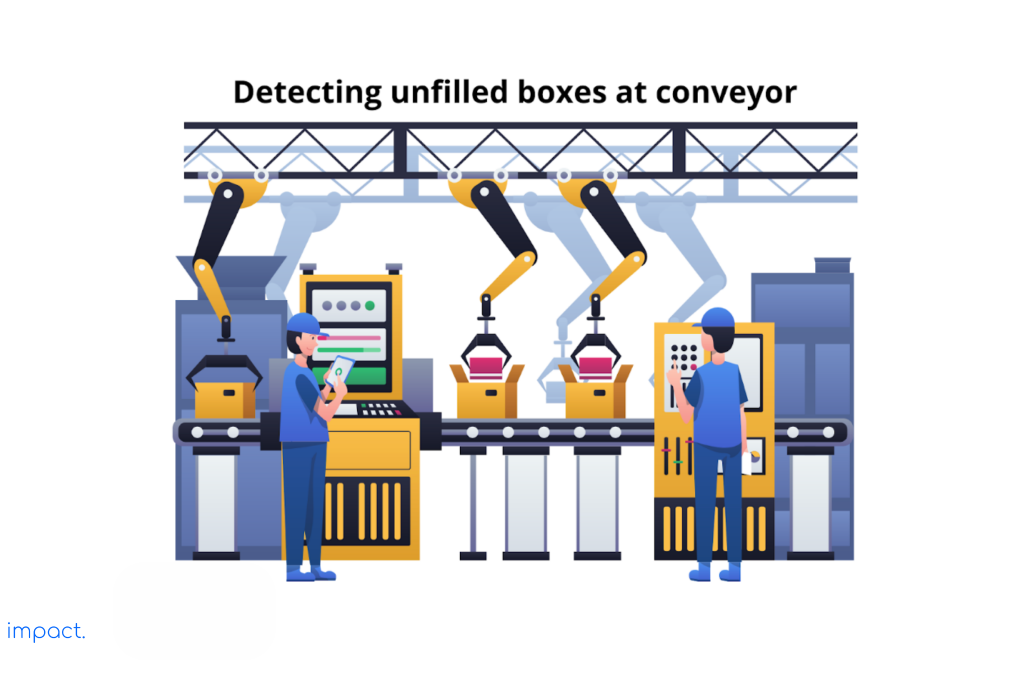
Previously, detecting unfilled boxes in the consumer product industry posed a challenge for companies. Occasionally, boxes would remain unfilled due to machine errors, yet they were still closed and sent for shipment.
To address this issue, companies employ Poka yoke through the following measures:
Read more: Jidoka: Definition and its 2 Implementation Strategies
Poka-yoke is a manufacturing method that prevents defects and errors in production. It involves two actions: stopping the machine and providing a warning in case of a mistake. Poka-yoke is commonly found in manufacturing companies that heavily rely on devices.
Having understood the concept of Poka yoke, the next chapter will discuss involvement, the core of the House of Lean Production.
Dennis, P. (2017). Lean production simplified: a plain-language guide to the world’s most powerful production system. Crc press.
Impact Insight Team
Impact Insights Team is a group of professionals comprising individuals with expertise and experience in various aspects of business. Together, we are committed to providing in-depth insights and valuable understanding on a variety of business-related topics & industry trends to help companies achieve their goals.
See how our software provides better value.
Speak with our consultant to explore how we can improve your accounting, processes, and people.

Jidoka is an integral part of Lean Production, just like the Just-in-Time (JIT) system we discussed earlier. While JIT focuses on product quality, Jidoka ensures quality is built right from the beginning. Without Jidoka, the Lean system could become imbalanced and fall apart.

Jidoka operates on these three fundamental principles:
Let’s look closely at Jidoka, including its meaning, why it’s essential, and how organizations can apply it in practice.
Jidoka comes from the Japanese term “ji-do-ka,” comprising three Chinese characters. Ji represents workers who must stop the production line when they find a mistake and produce a faulty product. Do mean motion or work, and Ka indicates the suffix “-ation.”
Jidoka combines automation and human intelligence, allowing skilled workers and machines to find problems and take appropriate actions to fix them quickly.
Jidoka follows four essential rules to make sure that products are perfect:
Jidoka strengthens the production process by continuously enhancing three key aspects:
In the past, people might not have fully understood the revolutionary nature of Jidoka as an approach to quality management.
Read more: Lean Manufacturing: Definition & 3 Benefits
Sakichi Toyoda, the founder of Toyota, developed the Jidoka concept. In 1902, he made a clever loom that would stop automatically if a thread broke. This invention transformed the industry by allowing one person to handle many looms.
Sakichi’s invention had significant advantages. It reduced mistakes, cut waiting times, and improved productivity. He also suggested it was okay to pause production to find out why defects were happening.
Expanding on Sakichi’s ideas, Shigeo Shingo took the Jidoka concept further. He aimed for “zero defects” and introduced the idea of Poka-yoke. Shingo also developed source inspection to support Poka-yoke. He even showed that it was possible to inspect everything during production without spending too much money.
The high defect rate leads to frequent line stoppages, hindering flow and pull. When this happens, it causes damage to spare parts, leads to wait times longer, and increases production costs.
Shingo’s statement holds regarding humans and their propensity for making mistakes. Data from US military and aerospace programs have confirmed that humans often emerge as the least reliable component in complex systems.
The figure below illustrates the typical error rates associated with different human tasks. The left side of the scale denotes the highest error rate, while the right side represents the lowest human error rate.

Source: Dennis, P. (2017). Lean production simplified; Human error rates. (Courtesy of Lean Pathways Inc., Copyright 2014.).
Even extensively trained military personnel exhibit an error rate of approximately 20% during simulated martial law scenarios. The optimal performance level achievable by humans is one error for every 10,000 attempts, equivalent to 100 parts per million.
Based on the data we mentioned earlier about human error rates, it’s clear that we can’t eliminate mistakes made by people in production. So, we need to use different methods to ensure workers are dependable. We discussed these methods in the previous chapter, such as standardized work, visual management, and 5S.
In addition to these methods, Jidoka also uses other techniques to improve worker reliability. Two of these techniques are called Poka-yoke and the inspection system. Here’s an explanation of each:
Poka-yoke means using a simple and cheap device to catch mistakes before they happen or stop them from causing damage.
A good poka-yoke should have these qualities:
The people working on the shop floor usually have the best poka-yoke ideas because they are actively involved in the production process.
Every level of management, starting from the team leader and going up to the supervisor and plant manager, should consider zone control. Let’s take the team leader zone as an example, which includes the team and its work area. The upstream and downstream team zones represent the supplier and customer, respectively.
This way of thinking promotes the development of duplicate controls, which are crucial in reliability engineering. Additionally, Jidoka employs an inspection system to ensure zero defects. Here are some of the inspection systems used in Jidoka:
The purpose of judgment inspections is to prevent defects from reaching the customer or other processes. A different department usually performs these inspections after completing a task. Finding the cause of the problem or providing feedback to those responsible for the mistake is not a significant focus during these inspections. Instead, they focus on determining whether something is good or not.
Informative inspections are all about finding problems, not mistakes, and giving feedback to fix them. They often use statistical tools like sampling protocols and Statistical Process Control (SPC).
Informative inspections are usually better than appraisal inspections, but sometimes there’s a delay in giving feedback and taking corrective action. The most useful informative reviews involve doing self-checks or checking relevant factors one after another.
U-shaped cells help with self-checking by placing the starting and ending processes next to each other. In each check, the following procedures look for defects and give feedback. These repeated checks work best when they cover all the items. The assembly line is a good fit for this kind of inspection.
Source inspections are inspection methods that actively search for faults that can cause defects and give prompt feedback to the source. We can categorize source inspections into two types: vertical inspections and horizontal inspections. Let’s take a closer look at each type:
To inspect this source type, search upstream for the root cause. For example, if there’s a water leak in the assembly, it may be because the paint shop didn’t apply the sealant properly.
Companies can quickly identify and address common problems using a standardized problem-solving approach and implementing a solid feedback loop. This feedback loop operates upstream and downstream and is vital for improving process capability and containment.
In these inspections, we actively search for the root causes of problems within the department. For instance, the lack of techniques to ensure the installation of all required parts often leads to defects and loss in assembly shops.
Toyota actively encourages supervisors in each department to establish feedback loops. These feedback loops enable supervisors to address and correct any defects that arise promptly. They want every supervisor to adopt a mindset similar to that of a small business owner, considering suppliers and customers when making decisions.
To keep improving quality, you need a long-term plan for Jidoka. Here are some essential things to do:
By doing these things, you can keep using Jidoka successfully. Setting yearly goals and having a long-term vision for Jidoka is also helpful.
Include Jidoka in your overall Lean manufacturing plan. When implementing Jidoka, make sure to address the questions mentioned earlier and also consider the following points:
Set annual goals for the following:
Percentage of team members participating in Jidoka activities.
Systems need to foster improvement to maintain jidoka. Start by assessing the company’s process capability level. You can determine the status by assigning scores and ratings to each process.
Ensure the scoring system is straightforward and doesn’t require complex statistical methods. Any team member should be able to evaluate a process and develop improvement ideas. Moreover, the system should offer clear guidance on progressing from one level to the next.
idoka, a concept utilized by Toyota, involves the famous andon process. This process encourages workers to halt production when they identify a significant problem immediately. Jidoka consists of two key elements:
This process allows us to:
Machines are superior to humans in detecting defects and halting processes. However, humans excel in problem-solving, making them better suited for Jidoka implementation.
Read more: Just in Time (JIT): Definition & 8 Application Steps
Jidoka is a concept created by Sakichi Toyoda and expanded upon by Shigeo Shingo. It plays a crucial role in achieving high-quality results at the lowest cost and in the shortest time possible. We can implement Lean manufacturing production by adopting a long-term jidoka strategy.
In the following chapter, we will go into detail about Poka-yoke. The chapter will explore its application and various types.
Dennis, P. (2017). Lean production simplified: a plain-language guide to the world’s most powerful production system. Crc press.
Impact Insight Team
Impact Insights Team is a group of professionals comprising individuals with expertise and experience in various aspects of business. Together, we are committed to providing in-depth insights and valuable understanding on a variety of business-related topics & industry trends to help companies achieve their goals.
See how our software provides better value.
Speak with our consultant to explore how we can improve your accounting, processes, and people.

Value Stream Mapping (VSM) supports the formation of Just-in-Time, as explained in the previous chapter. By implementing VSM, you can visualize, analyze, and improve all steps in product delivery.
In today’s saturated market conditions, it’s challenging to convince customers. Therefore, it is crucial to provide the value they need.
VSM is a strategy to enhance excellence and create the value customers seek. Let’s dive into the definition, process, and objectives of Value Stream Mapping.
Value Stream Mapping (VSM) is a helpful tool for understanding your company’s current state and finding ways to improve. It shows you a detailed picture of every step in your work process, from getting supplies to delivering products or services to customers.
VSM covers all the essential steps to provide value, giving customers what they want to pay for. For example, a software company’s value comes from its software solution and its features.
It’s worth noting that not all work processes directly give value to customers. Some procedures, like quality control, don’t require customers to pay extra. However, without quality control, the product or service’s quality would suffer, and it wouldn’t match what customers want.
So, even though it doesn’t directly bring in money, quality control helps ensure that the final product or service has the value customers expect.
Read more: Lean Manufacturing: Definition & 3 Advantages to Utilize
Various industries like banking, healthcare, and insurance implement VSM. The symbols depicted in the figure below represent the components of VSM.
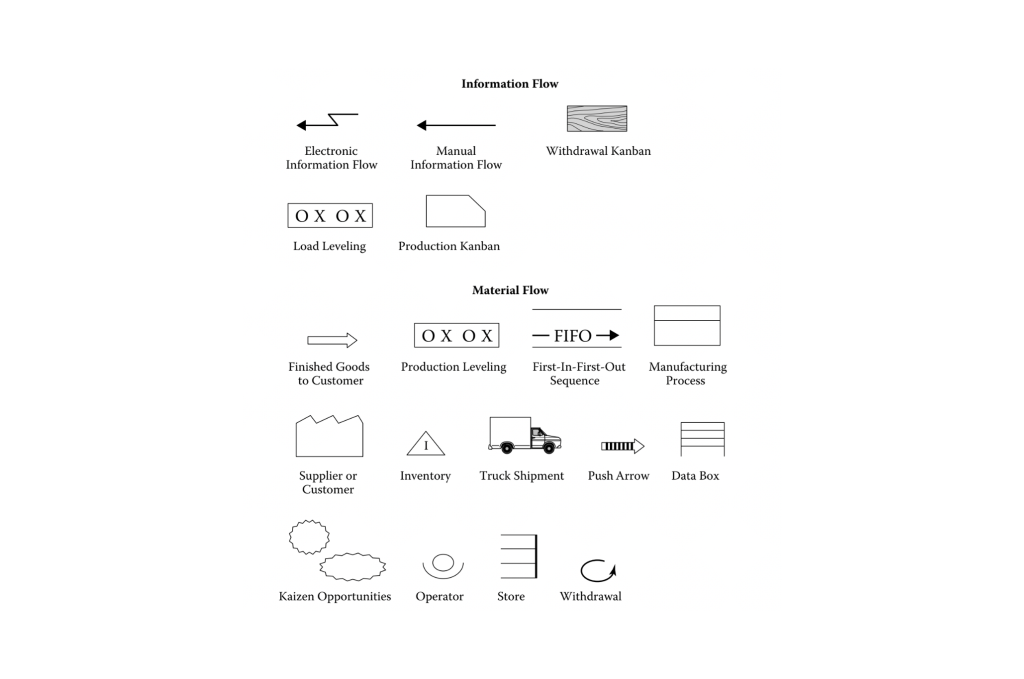
Source: Dennis, P. (2017); Lean Manufacturing Simplified; Value stream mapping symbols.
St. Clair Pallet, a company that makes business pallets, uses these symbols to show how they work. They cut, shape, and put together different kinds of wood.
Currently, the manual scheduling of production is conducted by the production manager for each process, relying on perceived daily priorities. The schedule undergoes frequent changes, represented by the dotted lines. Lead times vary between 12 to 15 days, and approximately 10% of orders are not delivered on time.
Workers are compensated based on the work completed and strive to work as quickly as possible. Assembly cycle times are inconsistent, ranging from 80 to 120 seconds. Inventories are high in both the wood yard and between each process. The time required for equipment changeover is 30 minutes at the multisaw and 20 minutes at the notching machine.
Waiting times at each process are significant due to shortages of small parts, machine downtime, and changeovers. The “spiky clouds” indicate potential areas for improvement (kaizen opportunities) and serve as the foundation for our future-state map
The picture below shows how things are now, called the current-state map. Based on the day’s priority, the production manager plans the work for each step by hand. The plan often changes a lot (shown by dotted lines). It takes 12 to 15 days to finish an order, and about 10% of orders are late.
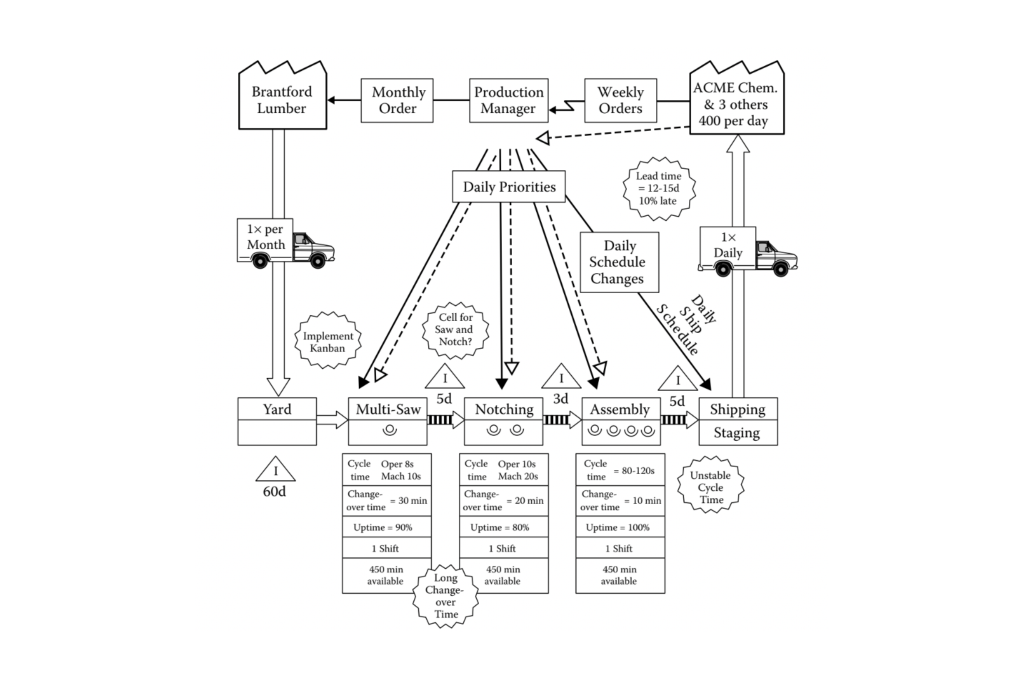
Source: Dennis, P. (2017); Lean Manufacturing Simplified; Current-state map, St. Clair Pallet.
Workers receive payment based on their wages and strive to work quickly. The assembly cycle time fluctuates between 80 and 120 seconds, exhibiting instability. The multi-saw requires a changeover time of 30 minutes, while the notching machine necessitates 20 minutes for the same process.
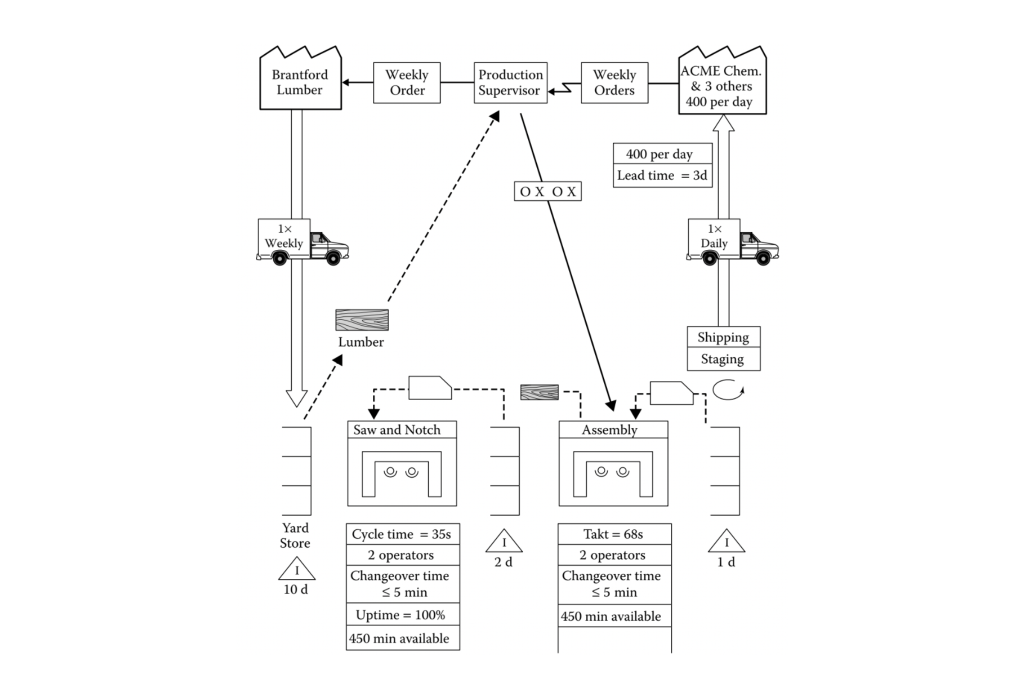
Source: Dennis, P. (2017); Lean Manufacturing Simplified; Future-state map, St. Clair Pallet.
Machine downtime and changeover cause lead times in each process. The “spikes” in the future-state map (shown in the figure above) indicate Kaizen opportunities. Here are some planned improvements:
We need to do several Kaizen activities to support our desired future goals. These activities include:
The main goal of Value Stream Mapping is to find ways to improve processes by visually showing the steps that add value and those that don’t. It involves analyzing each step in the workflow to see how it benefits the customer.
This analysis allows for a thorough examination of processes, giving clear insights into areas that need changes to improve overall efficiency.
Value Stream Mapping offers several significant benefits:
Kanban is a highly dependable tool for Value Stream Mapping. It offers an intuitive user experience and facilitates easy modifications. To begin mapping your Value Stream with Kanban, you only need two essential elements: a Kanban board and Kanban cards for all team tasks. Now, let’s dive into the steps you can follow to start with Kanban Value Stream Mapping.
If you’re new to workflow visualization, start small. Begin with a single team or department. Ensure you select the most convenient method to map out your Kanban workflow—whether it’s a physical board or Kanban software.
Gather the team and communicate the goals of the Value Stream Mapping. Kindly specify your objectives for implementing it.
Visualize your process together by default. A Kanban board includes three work item states: Requested, In-progress, and Done. Here’s an example of a Kanban board visualization:
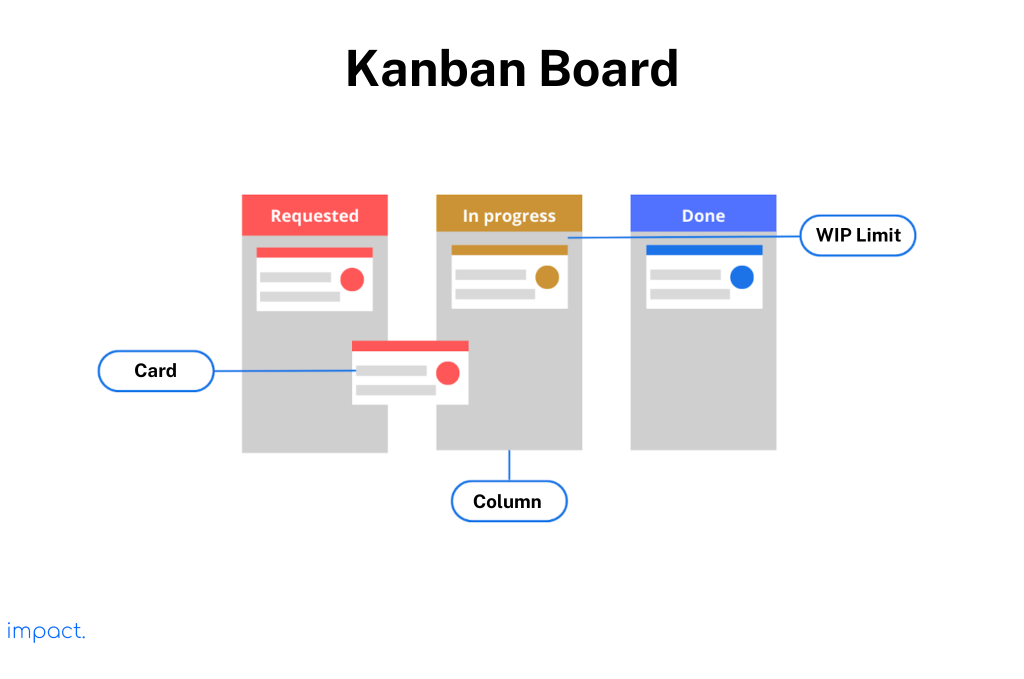
Ensure you select a variety of performance metrics to monitor when implementing streamlined work processes. Some of the essential Key Performance Indicators (KPIs) to consider in your workflow are as follows:
To optimize work efficiency, it is crucial for the lead time and cycle time to align with each other closely.
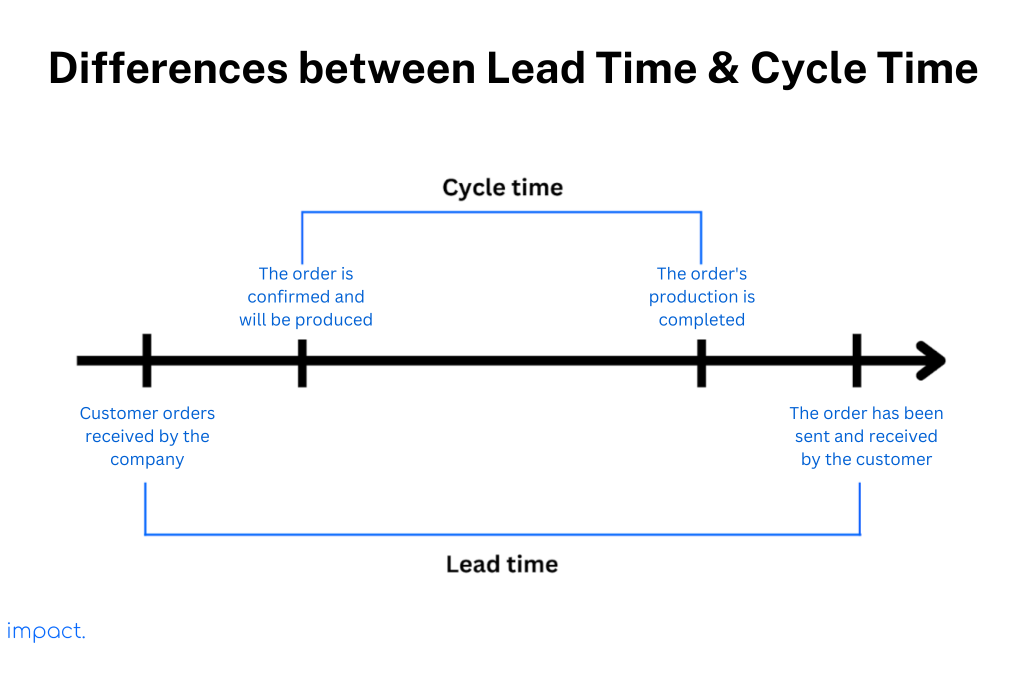
To maximize throughput, prioritize maintaining a high level without compromising the quality of customer value.
Work-in-Progress (WIP) is a crucial indicator in Lean Manufacturing and Kanban. The greater the WIP, the more waiting time will accumulate. Therefore, limit the number of tasks your team can handle simultaneously and adjust workflow data accordingly.
Regularly monitor these key performance indicators (KPIs) and be open to experimenting with the addition or elimination of process steps and advancing your workflow.
Read more: Kanban: Definition, 6 Rules, and its Benefits
Value Stream Mapping is a tool used to help visualize in detail all steps in the work process from supplier to customer. VSM aims to improve operations by visualizing value-adding and waste steps. In its implementation, VSM is closely related to Kanban.
Once you grasp the concept of VSM, the next chapter will focus on Jidoka. Jidoka is another critical element of the House of Lean Production.
Dennis, P. (2017). Lean production simplified: a plain-language guide to the world’s most powerful production system. Crc press.
Impact Insight Team
Impact Insights Team is a group of professionals comprising individuals with expertise and experience in various aspects of business. Together, we are committed to providing in-depth insights and valuable understanding on a variety of business-related topics & industry trends to help companies achieve their goals.
See how our software provides better value.
Speak with our consultant to explore how we can improve your accounting, processes, and people.
